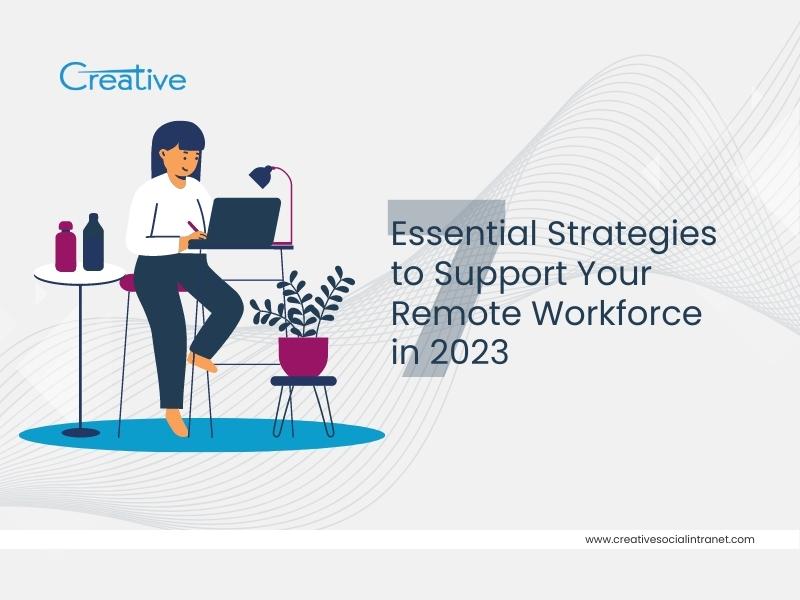7 Vital Strategies for Managing Your Remote Employees in 2023
Date: 09-Oct-2023

We are aware that the pandemic and broader social changes have made remote and hybrid working inevitable, but business leaders frequently ask us how to manage a remote workforce efficiently.
When given the option to work remotely, employees are more engaged, more likely to stay with their employer, and enjoy a better work-life balance, but they can also struggle with motivation, collaboration, and communication. Similar obstacles to remote work may also be encountered by people working from non-centralized, off-site locations.
These 7 key strategies cover crucial elements for better-connected and supported remote employees in 2023.
Just 32% of the 2,008 office workers surveyed by DocuSign in Australia said working from home makes them feel more connected to their coworkers than working in an office. It’s time, if you haven’t already, to concentrate on your intranet communication software to improve remote workers’ sense of connection. Everyone in the new hybrid workforce era, whether they are fully remote, working full-time in the office, or a combination of both, benefits from being able to collaborate and communicate with ease.
Through project- and topic-based workspaces, the ideal intranet solution can simulate physical collaboration environments for remote workers.
Key Performance Indicators are an extremely efficient way to assess both individual and organizational performance, but they might not be as pertinent if the individual or team has recently shifted to remote work. Metrics that have been updated may more properly represent how productive people are when they work from home. In allowing workers to understand precisely what is asked of them, they will also aid in setting clear expectations for them.
Consider broadening the scope of your key performance indicators (KPIs) to include communication and self-discipline as the cornerstones of your successful remote work strategy. You should also reevaluate your KPIs for each individual’s role. Keep in mind that KPIs need to be SMART, specific, measurable, attainable, and time-based.
There are many advantages to working remotely, and according to a Salesforce survey, 66% of respondents say it has made them more connected to their families. Working from home, according to employees, has improved their work-life balance, but achieving this balance can also necessitate a more accommodating attitude towards the times and locations of work. After all, does it really matter if the job is completed and done correctly if an employee wants to divide their workday into early morning and late evening work sessions?
Over half of Australians are willing to accept a pay cut in exchange for more flexible working hours, indicating that there has been a slight shift in the employment landscape. 76% of Australians say they would stay with their employer longer if they offered flexible working hours. Keep this in mind when developing support for remote workers as organizations that fall behind the curve may find it difficult to hire new employees.
In order for a digital workplace to be successful, leadership and remote teams must both feel a strong sense of trust. The natural inclination might be to install employee monitoring software and keyboard tracking, but Big Brother doesn’t really need to be watching over remote employees most of the time. Instead, develop those critical performance indicators and concentrate on encouraging high levels of employee engagement, which can have a significant positive impact on employee loyalty and productivity.
You can encourage faith and confidence in your remote teams in a variety of ways, such as:
We created a brand-new intranet for the top intellectual property firm FB Rice that collects helpful team data like staff codes, pictures, and whether someone is out of the office right now. Employees who work from different offices and from home can connect thanks to features like these and the ability to share and celebrate organizational successes.
One of the best things about remote or hybrid employees is that your hiring pool expands to include talent from well beyond your immediate area; there is essentially a world of knowledge and skill sets to be discovered! Many businesses are seizing the opportunity to develop a diverse talent pool with an emphasis on technological skills, which supports current employees and benefits the business as a whole. Just bear this in mind:
Since we’re talking about training, it’s important to point out that an efficient LMS can help both existing employees and new hires. Beginning with hiring and training to ongoing professional growth and developing skills, the right intranet design with an integrated LMS can offer a learning hub.
Remote employment can sometimes make employees feel as though their careers are on hold, but with the right remote training and growth strategy in place, this doesn’t have to be the case.
Remote workers can complete courses at their own pace, identify relevant resources with ease, and access staff contact information for any one-on-one questions about what they’re learning. Regardless of whether you have long- or short-term plans for remote working, this kind of efficient remote learning can really help to future-proof your workforce.
When employees are working from home or other remote locations, it is crucial to regularly solicit their feedback because even minor issues can silently worsen if left unattended. Starting to ask your remote employees for suggestions on how to improve their working conditions and output is a good idea. For instance:
By seeking this type of information via intranet surveys or a digital “suggestion box”, users may recognize valuable insights to enhance remote employee engagement and productivity.
Why not grab some coffee and view our presentation on this topic for more advice on assisting your remote workers? Along with important long-term approaches, it covers the crucial components you must not forget when establishing your digital workplace.
Since you’re currently searching to revamp or enhance your intranet software application, Creative Social Intranet wants to offer the tested platform and professional team to create your directly integrated digital workplace. Set up your free demo today.
ENGAGEMENT DRIVE PERFORMANCE